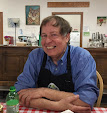Common ground and cultural blender
I'VE HEARD neighborhood activists many times talk about their community work as a search for "common ground." Recently, I read an essay which takes that idea one step further, suggesting that community-building requires not only seeking, but also "cultivating" common ground.
Gardening is a wonderful metaphor for working together. In a garden, there is a kind of equality among participants. And there is a great sense of collaboration when all are planting and weeding together.
That collaboration reaches its peak at harvest. That's the time when gardeners share their produce, trading tomatoes and jalapenos, cantaloupe and kohlrabi. You might think of this trading as a giant cultural blender.
Gardens are just one place where this blender is whirring. If you look closely, you can find this find the mixing and remixing going on all over the place.
In Minneapolis, I lived next to a Middle Eastern restaurant which specialized in gyros. But the restaurant also offered bratwurst. Down the street a Chinese restaurant proudly displayed a sign reading: Se Habla Espanol.
The recent emergence of Day of the Dead celebrations around the Midwest offers a very great example of this cultural blending. The event itself is a blend of influences which have been mixing for centuries. The festival has been a tradition in Mexico and parts of the southwest US for years. Now, it's also celebrated in cities all over the US, including Minneapolis and Iowa City.
One part of the festival is building ofrendas, small memorial altars which pay tribute to those who have died. In the past, these ofrendas have usually been tributes to family members. But in Minneapolis, I saw a public display of ofrendas which included not only family members, but also shrines to Tupac, Martin Luther King and Princess Diana.
Iowa City's Day of the Dead celebration shows another way this cultural blending is at work. In that city, it is a very multicultural group which has shaped Day of the Dead into a major celebration each November.
There is a liveliness in the mixing. New traditions are shaped by this blender.
But there are times where there is strong resistance to this blending. Columbus Day festivals are one example. In a number of communities, these have become defiant tributes to a past that never was.
Many colleges and universities have had a hard time responding to this diversity. They have been quite willing to allow this cultural blender to operate around the edges, in such events as Diversity Day and Black History Month commemorations.
But have been less willing to allow the blender to broaden and strengthen the range of voices within academic departments. The best example of this has been the ongoing struggle to add African-American, Chicano and Native American voices to university departments. Women's voices, too, are often left out.
This is not a new problem, of course. Jane Addams wrote about this a century ago. She said universities have too often disconnected themselves from the real world outside the academy.
Hull House, the settlement she and others founded in 1889, was in part a response to this disconnection. Then, as now, many voices were excluded from the universities and museums. One response of Addams was to invite a broad range of people to speak and teach at Hull House. It was an early example of college extension classes. Another example: Major museums excluded the art and culture of many immigrant groups. So Hull House opened a museum to give those artists a place.
These and other Hull House initiatives are great examples of cultivating common ground and encouraging the work of the cultural blender. They are also models we can adapt for our time.

